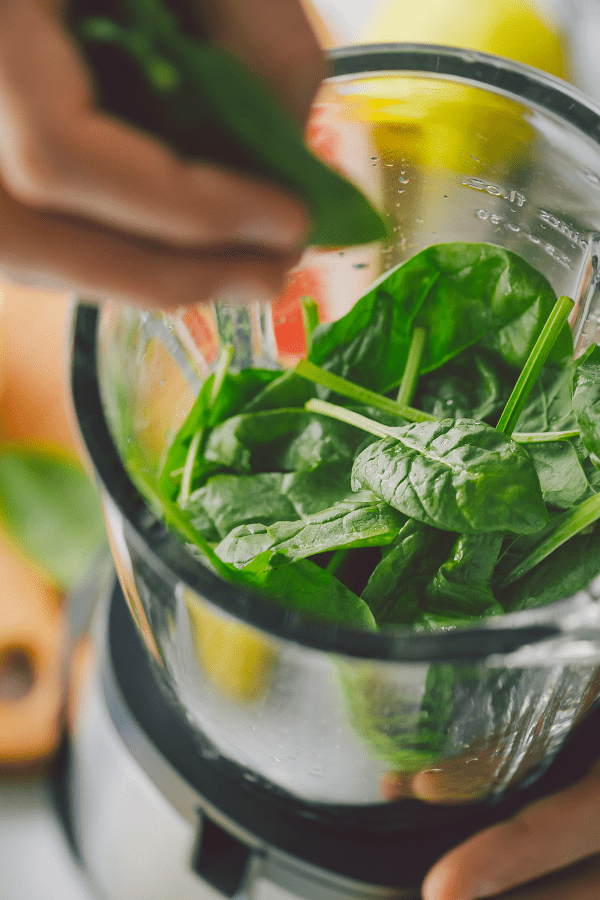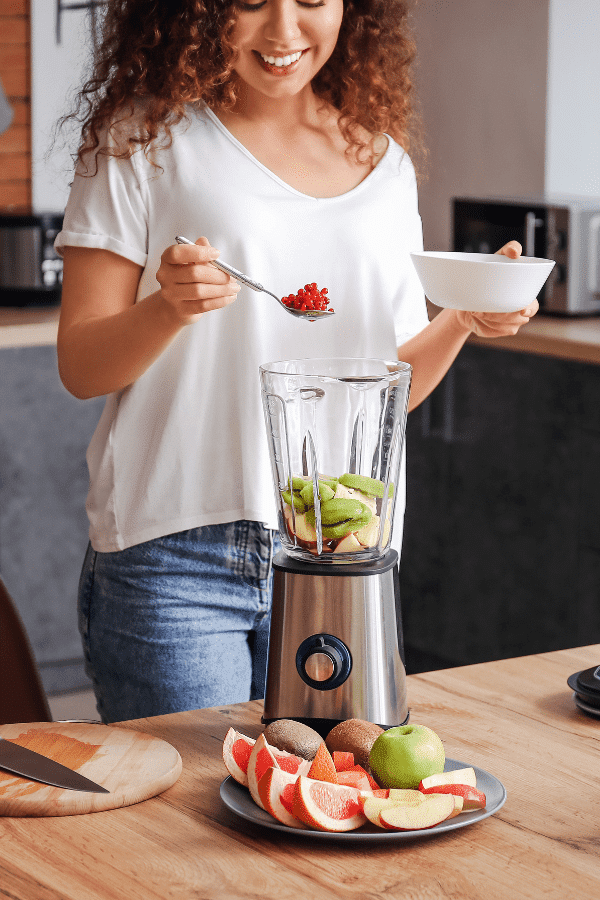Vitamix makes premium, high-quality blenders that have stood the test of time in many of our kitchens. These blenders can be used for simple fruit smoothies but also as food processors.
They are a handy, multi-purpose tool that can create delicious food with little effort.
However, the machines require a little TLC to keep them functioning at their peak.
Learning how to clean your blender will serve you in the long term and prevent any unhappy accidents.

There may be affiliate links in this article. You can read more about this in my disclosure.
Is the Vitamix Container Glass or Plastic?
Vitamix used to make their containers out of stainless steel, but since the 1990s, they switched to a transparent polycarbonate. Polycarbonate is a type of plastic that can withstand high impact and is a lighter alternative to glass.
It’s less likely to crack and shatter than glass but allows you to see all the goodness you’re blending.
Can You Put a Vitamix Container in the Dishwasher?
The answer depends on which model of Vitamix you own. Many of the newer models are dishwasher-safe. For example, the Vitamix S-series 40-ounce or 20-ounce containers or the S 30 containers are dishwasher safe.
Check out the link below to compare your Vitamix, so figure out if yours is the Vitamix S-series or buy yourself one.
[amazon box=”B00V9ZOQY6″ template=”vertical”]
All of the other series and models are not dishwasher safe.
What Happens If You Put a Vitamix in the Dishwasher?
If you wash the Vitamix S or S30 series in the dishwasher correctly, following the guidelines outlined later in the article, your Vitamix should come out clean.
The components should remain unchanged and undamaged, and the container should be free from debris and dirt.
However, if you put other models in the dishwasher that are not dishwasher safe, the extreme heat can dull and rust the blades. Not only this, but the complex internal mechanisms in the base can be damaged, such as the ball bearings.
This damage does not necessarily appear immediately after washing the container, but in time faults can become more obvious, and problems can arise.
What Parts or Components of Vitamix Are Dishwasher Safe?
A Vitamix blender comprises a few parts- the container, the base blade, the electronic blender housing, and the lids and seals.
When cleaning the blender, disassemble all the components to separate the dishwasher-safe parts and the parts that are not.
The Vitamix S30 is the only model that is dishwasher safe. The container, lid, seal, and base blase can all be put through the dishwasher. What a time saver!
However, to prolong the life of the blender, Vitamix still recommends that you hand wash the blender most of the time to prolong its lifespan.
Can a Vitamix’s Stainless Steel Blades Corrode in the Dishwasher?
The stainless steel blades can still rust and degrade regardless of your model. Although stainless steel is one of the most resistant metals on the market, it will still wear away over time.
Washing any sharp-edged metal, such as a knife or a blender blade, in the washing machine will dull the edges. This will result in a slow blend of your food as the dull blade struggles to chop through your frozen fruit.
To prolong the blade’s lifespan and keep the edges sharp, try to wash the blender by hand most of the time.
Can You Put Boiling Water in a Vitamix?
Vitamix state that the containers can handle hot temperatures, and their blenders can be used to make hot, liquid foods, such as soup. However, they also state the maximum temperature the containers can handle is 170 degrees Fahrenheit, or 76 degrees Celsius.
Placing liquids hotter than this inside the container can cause the plastic to crack and break.
The boiling point of water is 212 degrees Fahrenheit or 100 degrees Celsius, which would be too hot for the polycarbonate container to handle. Therefore, it’s not recommended to put boiling water into the blender.
Unless you’re using a thermometer to check the temperature of your food before putting it into the Vitamix blender, you may want to err on the side of caution and let the food cool down significantly beforehand.
Many users have reported small cracks when putting hot ingredients into the blender, indicating that it may not be able to handle the temperatures it pertains to or that users are underestimating the temperatures of their food.
So save yourself the stress and hassle in the long run, and wait a little longer to blend up that butternut squash soup.

How to Properly Clean Vitamix Blender in the Dishwasher
If you have the S30 Vitamix blender and wish to use the dishwasher, you can take a few precautions to avoid damaging the blender.
Follow these steps to clean a Vitamix blender in the dishwasher properly:
- Separate the elements that are dishwasher safe and not dishwasher safe. The container, seals, and lid can be washed in the dishwasher, but it’s recommended that the blades are not.
- Place the elements on the top rack if possible, as less heat reaches the top shelf and thus will be less likely to damage the components.
- Set the dishwasher to a low temperature and a short cycle. The blender should not need much time to clean, especially if being washed immediately after use.
- Run the cycle, and remove the components before the drying cycle. The elements will air-dry quickly outside the dishwasher and thus can be spared unnecessary heat damage inside the machine.
- Hand clean the remaining components and leave all elements to air-dry.
- Reassemble the machine, and you’re good to go.
How to Clean the Vitamix Using Self-Cleaning Feature?
Vitamix has done an excellent job at making their machines easy to clean. The self-cleaning feature of the Vitamix means no disassembly is required.
Follow these steps to self-clean the Vitamix:
- Fill the container about halfway with warm water.
- Add a drop of dish soap and re-attach the lid.
- Set the machine to the clean setting.
- The blender should automatically turn off when the clean cycle has finished.
- Pour out the liquid and give the container and blades a rinse in warm water.
- Reassemble, and your blender should be clean.

How to Clean the Vitamix without Self-Cleaning Feature?
You can still follow a similar process if your blender does not have the self-cleaning option.
Follow the steps above, but instead of using the clean setting, set the blender to its highest speed and let it run for about one minute or until it looks relatively clean.
Alternative Ways to Clean a Vitamix
Over time and use, blender containers can become cloudy, and food remnants can build up. Not only does this mean you can’t see the contents of the container as clearly, but it also means small particles will be transferred into your food and drink.
This is unhygienic and can make your fruit smoothies taste like last week’s potato and garlic soup.
What you will need:
- Warm water.
- White vinegar.
- Soft-bristled brush or abrasive sponge.
Try out this deep-cleaning method to clean your Vitamix:
- Rinse out the container and clean it with a bit of soap and water.
- Pour one cup of distilled white vinegar into the clean Vitamix container.
- Fill the container roughly halfway with warm water.
- Leave the container to soak for a few hours or overnight.
- After the vinegar mixture has soaked, pour out the liquid.
- Grab an abrasive spine or soft-bristled brush and start scrubbing the inside of the container. Be careful not to cut yourself with the blades; they can be pretty nasty!
- Rinse with warm water, and your blender should be clean and clear.

How to Clean Vitamix Blender by Hand?
Sometimes the self-cleaning cycle isn’t strong enough to remove the sticky contents of your blender, and a little elbow grease is required.
The main point of consideration when cleaning a Vitamix blender by hand is not to cut yourself on the blades.
Follow these steps to clean a Vitamix blender by hand:
- Rinse the container with warm water to get most of the residue out.
- Add a drop or two of dish soap, and top up the container to the halfway point with warm water.
- Use a toothbrush, a bottle cleaning brush, or even a sponge to clean the inside of the container. Again, be careful not to cut your hand on the blade. This is when using a brush with a handle is valuable.
- Pour the contents out and rinse the container.
- Wash the lid with a sponge in the sink with warm water and soap.
- Leave the blender to air dry or dry with a towel.
Conclusion
Blenders are a must-have kitchen staple, helping you create deliciously smooth drinks, soups, and sauces. Unfortunately, Vitamix blenders can be expensive, so you must follow a few steps to care for your equipment.
Washing the blenders by hand or using the send cleaning cycle is the best way to keep the blender clean while extending its lifespan.
But if you are planning on using the dishwasher, try to use the top rack and use a cool, short cycle.



